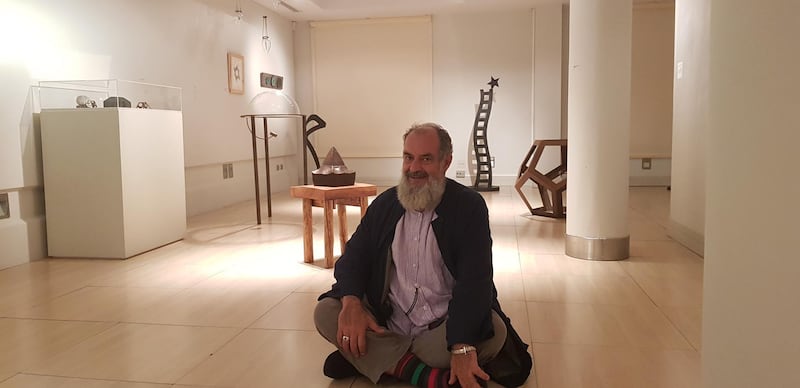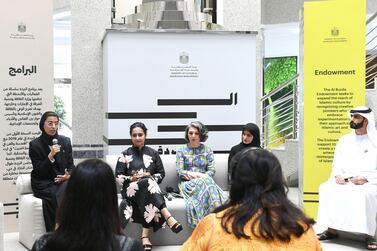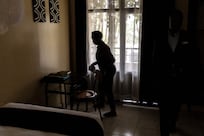Ibn Arabi has been described as many things over the years. The 12th century Islamic figure has been referred to as a spiritual guide, a leader, an academic and a traveller. However, artist and sculptor Cristobal Martin wants one thing to be known of Arabi – that the pre-eminent figure was also Spanish.
This is one of the key aims of Martin's exhibition, The Nocturnal Star, currently being shown at the Casa Arabe cultural institute in Madrid. Consisting of nearly two dozen pieces – from majestic iron sculptures to whimsical glass-and-metal installations – Martin's exhibition attempts to convey the spirituality so central to the life of one of Islam's greatest heroes.
Yet this is all done within a Spanish framework. The exhibition's wall space has reams of Ibn Arabi's poetry translated into Spanish. There is also a glass panel case containing various other historical texts that retrace his life.
Martin says his showcase essentially pays homage to the man whose work first opened his heart to Islam nearly 25 years ago. In addition to residing in a Sufi community of 10 families living in a mountain village on the outskirts of Madrid, Martin is also known by his Muslim name Abu Wahid.
"It is weird. I travel the world and many people know about Ibn Arabi, but in Spain he is virtually unknown," he says. "This man is a hero from this land and no one knows that. So with this exhibition, I am trying to raise awareness of him and say 'thank you' for inspiring me to change my life."
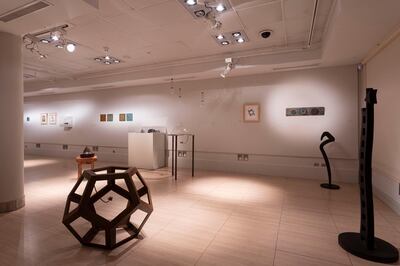
That intimacy permeates The Nocturnal Star. The exhibition is sparsely designed. Each piece stands alone and offers a chance to meditate on its meaning, which in true Ibn Arabi fashion is multilayered. There is a wavy bronze staircase with a star affixed on top, perhaps denoting that a spiritual life is rarely a straight path. There is also an iron dome, supposed to be a shell or a helmet, that stands on a tripod. It is an abstract piece, inscribed with a series of Arabic letters and engraved stars. And then there are two of the Arab world's most important letters (due to their mention in the Quran), Alif and Meem, beautifully rendered in solid black iron.
Martin shows me a drawing full of darkly sketched geometric patterns that lead to a small star in the middle. "This is what happened to me," he says. "This piece I did a few years after I became a Muslim and it basically tells you how that happened. Basically, I was a Muslim before I even knew it. My journey has always been about heading to that realisation, heading towards the centre of things and why I am here. Which, for me, is Allah."
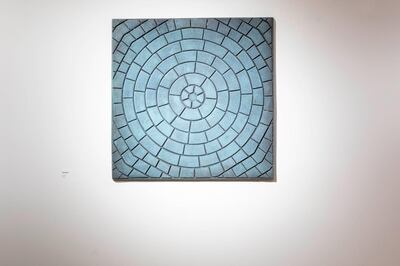
Guiding Martin on that path of discovery was Ibn Arabi. At that time, Martin was a frustrated artist and was feeling untethered. He had just got divorced and had quit his job as a civil servant before deciding to return to university to study philosophy. "I got my law degree for my parents," he says. "This time I came back for me."
During the philosophy course the students covered the work of Miguel Asin Palacious, a 20th-century Roman Catholic priest who went on to become a scholar of Islamic studies and arguably Spain's most famous Arabist. "He really is the one who discovered Ibn Arabi for the Spanish. At the time, in the early 1930s and 1940s, [Arabi] was unknown because the texts were in Arabic and in libraries in different places like Baghdad," Martin says. "Palacious studied Arabic and through that he came across Ibn Arabi and essentially dedicated his academic life to him. He even travelled to Damascus to visit his tomb. Can you imagine that? A Jesuit arriving in the mosque in Syria to visit Ibn Arabi?"
Palacious's interest in Ibn Arabi and Islam resulted in a tranche of thought-provoking books. In 1919's Islam and the Divine Comedy, he suggested that Dante's most famous poem was inspired by Sufi motifs. His 1931 work, Islam Christianised, remains one of the earliest and most important Spanish texts examining the life of Ibn Arabi. It was enough for Martin to go to the literary source, so to speak, only to find out that the mystic had been a local all along.
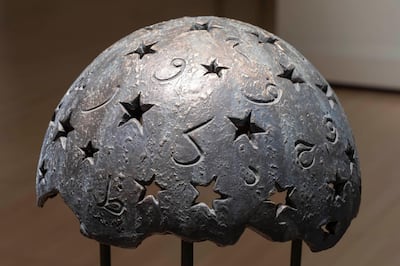
"Ibn Arabi was born in Murcia, which is in the south of Spain and then he moved to Seville," he says. "It was there in Seville, which at the time was like New York, that he received his first visions from God and it was from there that he decided to become a Sufi. This is a Spanish story, my friend."
In the course of diving through Ibn Arabi's various books and poems, many of which preach his brand of meditative worship, Martin converted to Islam on a beach in Barcelona in 1995. He puts Spain's ambivalent attitude to Ibn Arabi down to his country's uneasy historical relationship with Islam. "Personally speaking, from what I experienced here, there is still this feeling that the eight centuries [711 to 1492] where we were under Muslim rule is almost taboo to talk about," he says.
“There is still that quiet tension there and as a result, we don’t talk about people from that period. This is ridiculous because people like Ibn Arabi and many others great and important figures came from that time.”
Martin is optimistic, however, that the tide will turn and Ibn Arabi will eventually get the attention he deserves in his native land. The artist partly puts it down to a new and curious Spanish generation living in a more interconnected society, not to mention the timeless teachings of Ibn Arabi, himself.
“He always said that everything is alive and nothing is really dead,” he says. “I view my work and this exhibition as an antenna. I am just one of the many ways in which his lessons are being transmitted to people. This gives me satisfaction.”
The Nocturnal Star exhibition is at the Casa Arabe cultural institute in Madrid until Sunday. More information is available at en.casaarabe.es
